

What
You Need?
![]()
CAGE: Some
people buy their cages pre-made. If this is your plan, make sure you know
what you're getting. Most pre-made cages have a pull out tray below a wire
cage-bottom. Most people view this as a positive attribute. Ensure that the cage
has a cage fence with spacing of 0.5 inch X 0.5
inch. This is to cater for the future when there are Chinchilla births. Baby
Chinchillas are small and can easily escape from bigger opening cage fences. If it is, your chinchilla could get his/her leg
hung and broken. Don't think it won't happen
to you. This is extremely common because of chinchilla activity levels.
To help avoid this do not buy a ferret cage. Keep in mind
size limits: 2' X 2' with overhead "jumping
room".
They
are native to the Andes Mountains where they inhabit rocky ledges hence supply
them climbing shelves and ramps in your cage. There are cages are available that have multiple levels,
shelves and/or platforms which allow the chinchilla to climb are ideal.
For ease of cleaning, a pull out tray is a nice feature, and if possible there
should be a tray for each level so dropping don't fall onto cage furnishings
below. Galvanized wire makes the best cage material, as chinchillas will
chew plastic readily. To give the chinchilla a break from the wire floor,
a wooden platform can be provided, which they will also appreciate for chewing.
Also, a house should be provided (e.g. out of wood).
FOOD:
A good diet is so important to chinchilla health. Before you buy food, you will need something to put
it in! There are different types of
food for the chinchillas. Always
be sure that any food, timothy hay or alfalfa you use is fresh, free of mold,
mildew and toxic weeds.
In
Singapore's environment where air might be damp, good care must be taken to
ensure that a mouldy condition doesn’t arise. You
will want to keep the chinchilla on the same diet the breeder had them on for at
least a couple of weeks. If you want to change the diet, the new diet must be
introduced slowly. They are:
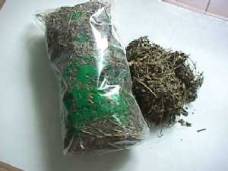 Hay Varieties---
Edible hay comes in all sorts of variety. Among all, the most common hay fodder
being fed to chinchillas would be timothy and afalfa. Timothy hay generally
gives the impression that it is more parched when compared to the other
varieties. Since timothy is less damp than most hay, it is known to be less
susceptible to mold if any. If
we use loose Timothy hay, we offer it in the morning and evening . It is good
for their digestion and keeps things moving. You can’t give a chinchilla too
much fresh hay. For most owners, when
diarrhea occurs, alfalfa feeding is reduced while an increment in timothy hay is
imminent.
Hay Varieties---
Edible hay comes in all sorts of variety. Among all, the most common hay fodder
being fed to chinchillas would be timothy and afalfa. Timothy hay generally
gives the impression that it is more parched when compared to the other
varieties. Since timothy is less damp than most hay, it is known to be less
susceptible to mold if any. If
we use loose Timothy hay, we offer it in the morning and evening . It is good
for their digestion and keeps things moving. You can’t give a chinchilla too
much fresh hay. For most owners, when
diarrhea occurs, alfalfa feeding is reduced while an increment in timothy hay is
imminent.
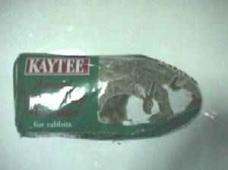
Alfalfa
is also a common class of hay found in many pet stores. It is mostly found as
leaves, straws or in the form of chewable cubes. When placed in the same tray as
timothy hay, most chinchillas will sift and pick out the alfalfas since it is a
better favourite.
When buying your chinchilla's hay there are a few things that you should be aware of. The very first thing to know is to never take hay from a local field just to save a few dollars, because it can end up costing you more in vet bills.
There are
three reasons not to:
Pellets: Pellets
should be given as part of a chinchilla's daily diet. The proper pellets give
chinchillas the nutrients they need for proper growth and development. Two
teaspoons of pellets should be allocated to each chinchilla everyday and
untouched pellets ought to be cleared daily. It is also reasonable to mix a bag
of pellets with a teaspoon of vitamins to give chinchillas a healthier lifestyle
as well as a good shiny fur.
Do
note that proper air-tight containers must be used to hold pellets after the
seal is opened. If the pellets have a strong stench or smell oily, it is best
discarded.
Treats: A
fun way to own a chinchilla is to feed them treats every now and then.
Chinchillas are notorious little beggars when it comes to raisins. It is always
a soft and warm sight to see them waiting at the cage door with their paws up,
eagerly anticipating a nice little treat from the owner.
 Eight in One Ultra Blend Chinchilla Treat
Eight in One Ultra Blend Chinchilla Treat
Treats
have always been given to chinchillas as controlled food. It is unwise to give
huge amount of goodies to them on a daily basis because it is inadequate for
their digestive system. For example, Pregnant/lactating
females, we usually supplement their diet with a small amount of calf’s manna
and sometimes an 1/8 tsp. yogurt as a treat. Our chinchillas tend to favor the
strawberry, banana or mixed berry yogurt flavors, and usually make a terrible
face the first time we offer it. For
example, an adult chinchilla should be able to eat one small sized raisin
without coming up with complications such as diarrhea.
You will only want to give
your chinchilla one very small treat a day. Some acceptable treats are apple,
carrot, dried cranberry, sunflower seeds, and raisins. I think that your
chinchilla should receive one raisin per night to prevent constipation. You can
mix 1 or 2-shelled sunflower seeds with their pellets. If you want to give your
chinchilla a dried cranberry, it is ok to give them 1 cranberry. However, if you
want to give your chinchilla a very small piece of apple or carrot, I would
recommend not giving the raisin that night. Some people feed their chinchillas
different types of nuts, but I advise not to, because they are very high in fat.
You can make your own
supplement. Ingredients can be found at a local health food store, or feed
store. The following recipes is taken from Laurie Soehn.
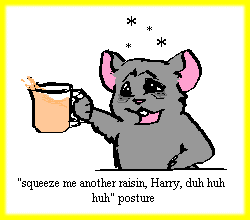
Recipe
#1
Recipe #2
Recipe #3
Recipe #4
DO
NOT give baby chinchillas treats until after they are 4 months old. And even
then, do it gradually. Their digestive systems are not developed well enough and
the treats can cause diarrhea. A baby chinchilla with diarrhea is not fun for
the baby, the mom, its siblings or for you to clean up. Expectant mothers should
have hay available at all times. You can either feed a couple raisins to help
alleviate constipation, or part of a plain shredded wheat biscuit to help
alleviate diarrhea.
WATER
BOTTLE: A rabbit water bottle is generally a good buy:
inexpensive, easy cleaning. If you are able to get a glass
water bottle Definitely buy it! (Remember the teeth.)
Try to find a bottle that hangs from the cage in a metal
hanger. If you have to get a plastic bottle, and it is not protected by a
metal hanger, the chin will eat through it quickly.
FOOD
BOWLS: Chinchillas love to sit as high as they can be.
If that means sitting on top of a food bowl 1 inch off the ground, then they'll
do it. The yucky result is chinchilla poo and pee in the food. One
recommendation I've heard is to buy one of those ceramic frog pot & pan
scrubber holders. They can't eat it, can't sit on it easily, and they
can't stick their rear ends in it.
It should be a heavy ceramic bowl to reduce tipping, and it must be cleaned
daily. For feeders, hopper style feeders that attach to the outside of the cage
are nice because they can't be tipped and the chinchilla won't be able to
urinate in their food.
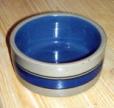
Chinchillas will eat about
one or two tablespoons of chinchilla pellets per day. Don't feed them
rabbit food; there's still a debate about this. As for treats they can
have one or two per day, consisting of: raisins, Cheerioes, dried
cranberries, Corn Flakes, or dry oatmeal. Don't let them talk you into
giving them more! You'll
need some timothy or alfalfa hay!.
TOYS: Toys can be provided too - blocks of wood and tree
branches (only wood that has not been exposed to pesticides) will be
appreciated. Some of the wooden parrot toys make good toys as well.
It is important to provide toys that will stand up well to chewing and that do
not have small or plastic parts that could be ingested. In addition, a
"chinchilla block" or pumice block can be provided for chewing and
this will aid in keeping the teeth trim.
Wheels can provide excellent
exercise, although you may find that unless the chinchilla is introduced to the
idea at a fairly young age it may not take to running on a wheel. A 15
inch wheel is preferable, and one that attached to the cage via a system of ball
bearings on the side with the other side completely open makes it a little safer
for the chinchilla (as does one with a flat running surface instead of open
wires). It is also possible to get translucent plastic balls in which the
chinchilla can "roll" around the house by running - keeping the
chinchilla and the furnishings safe. I actually do a special report on
exercise wheels so please
click on the picture below it which is showing a chinchilla coming out of the
running wheel. Again, getting a chinchilla used to
this at an early age will make them most comfortable with this.
 You
might want to buy a running wheel for your chinchilla to work off some of that
energy. Recommended is a wheel at least 12" in diameter with a flat/solid
running surface. Sources: ChinsToGo and
Valley View Chinchilla Ranch, Jim & LurLee Adams, 752 Busch Dr., Vista, CA
92083, 619-726-6356.
You
might want to buy a running wheel for your chinchilla to work off some of that
energy. Recommended is a wheel at least 12" in diameter with a flat/solid
running surface. Sources: ChinsToGo and
Valley View Chinchilla Ranch, Jim & LurLee Adams, 752 Busch Dr., Vista, CA
92083, 619-726-6356.
Chinchillas must chew!
If they are not allowed to chew their teeth will over grow and it can kill them.
Get some non-treated pine 2X4s or dowels. Available at Wal-Mart, Lowe's. Home
Depot, etc.
Bedding: Must use pine
shavings as litter bedding. It has been identified by Pet industry people that
pine shavings generally are better absorbers as litter bedding. Change litter
bedding regularly (say once a week), to avoid build up of infectious bacteria.
Magots can be found in the litter bedding if not changed for a long time. From
my experience, pine shavings have better absorbent properties than other kinds
of beddings. If need be add baking soda powder to the shavings as deoderizers of
Chinchilla pee. Never use Ecualyptus, Red Cedar, Redwood,
and Plywoods, as litter absorbers due to their toxic nature to
Chinchillas.
If you have a paper shredder you can shred your newspaper
and use that as your bedding or you can even just line the droppings tray or
bottom of the cage with newspaper. This makes it very easy to clean, because you
can just fold the mess into the newspaper and throw it away.
Dust
Bathing: We offer our chinchillas a dust bath daily or
every other day as time permits. They love to bathe and their coats look
wonderful. We put 1/8 to ¼ cup of dust in a container and put it in the
chinchilla’s cage and they watch as they frolic. It protects the
chinchilla's coat by eliminating extra oils and moisture, leaving it healthy and
clean. You can use many types of containers from
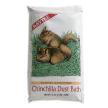 Pyrex bakers to
Tupperware. Our favorites are the chinchilla bath houses because they contains
the dust well. A good dust is Kaytee, but only the type in the clear plastic
bottle. We remove the dust bath after 3 or 4 minutes otherwise the chinchilla
will soil the dust with droppings or urine.
Pyrex bakers to
Tupperware. Our favorites are the chinchilla bath houses because they contains
the dust well. A good dust is Kaytee, but only the type in the clear plastic
bottle. We remove the dust bath after 3 or 4 minutes otherwise the chinchilla
will soil the dust with droppings or urine.
Bathing is very important for
maintaining a healthy chinchilla. They require a "dust bath" at least
twice a week but would prefer one daily. Chinchilla dust, is actually volcanic
ash can be purchased at most pet stores. Since they will roll on their sides
vigorously covering themselves, we use a plastic pet container on its side with
the small opening to keep most of the dust on the inside instead of everywhere
else in the room.
Bath House:
You can purchase the dust for your chinchilla at a pet store. I believe they
sell specific dust bath containers, but a number of things will work well and be
cheaper to purchase. We do not recommend putting the bath container in their
cage, because the chinchilla will urinate and defecate in it, making it
un-usable. We actually recommend purchasing a cat litter box with the attached
hood. These work great; just put your chinchillas in there and they can roll
around all they want without hurting themselves or making a huge mess. These
boxes are very easy to clean and sterilize, if the need ever arose.
 This
picture is designed for the interesting and unique sand bathing behavior of pet
chinchillas. It will fit any pet chinchilla cage. It neatly contains
excess dust and sand and doesn't allow it to spill out on to the cage floor.
Promotes clean and healthy fur naturally. Just add a packet of the
Chinchilla Bath Sand and watch your pet toss and turn while performing the most
entertaining bathing behavior right before your eyes. A daily bath is
vital for your pet and now easy for you with this bath house. It can be
tucked into any corner, at any level on a cage, or attached to the outside of
Super Pet cages.
This
picture is designed for the interesting and unique sand bathing behavior of pet
chinchillas. It will fit any pet chinchilla cage. It neatly contains
excess dust and sand and doesn't allow it to spill out on to the cage floor.
Promotes clean and healthy fur naturally. Just add a packet of the
Chinchilla Bath Sand and watch your pet toss and turn while performing the most
entertaining bathing behavior right before your eyes. A daily bath is
vital for your pet and now easy for you with this bath house. It can be
tucked into any corner, at any level on a cage, or attached to the outside of
Super Pet cages.
Sleeping
House: A
chinchilla should always be provided with a sleeping box. Chinchilla prefer to
sleep on the highest level of their cage. This box gives the chinchilla a safe
haven, especially during the day while they sleep. You can either purchase
these, or build one yourself. If you are going to purchase one or build one out
of wood, the safest wood to use is untreated pine. Do not use cedar, redwood, or
plum; these are toxic to chinchillas.
Your
chinchilla will chew a wooden sleep house up, so you will eventually need to
replace it. You can find a sleeping box made out of very hard plastic that can
be used for a wide variety of small animals, including chinchillas.
Most
important is the sleeping house or hideout place for our Chin. It should be
closed and have a entrance in front. You can have the house somewhere mounted
towards the top of the cage, most of our Chins seem to like high spots for
sleeping.
Chew
Block: Chinchillas' teeth grow continuously, so it is
quite important to give them something hard to chew, so they can keep them down
to a good size. Some people take their chinchillas to a vet so the vet can
dredge them down, but this is totally unnecessary since you can easily provide
them with a chew block. You can use the chew sticks that pet stores carry for
hamsters or you can use a branch from an apple, pear, or mulberry tree.
You can also
use a block of unfinished pinewood. Do not use branches from a cherry, plum, or
citrus tree; they are toxic to chinchillas. You also need to make sure that the
trees you get your branches from have not been sprayed with pesticides of any
kind. You can also use branches from a pine tree as long as they have dried out
and contain no pine tar. Another wood that you can use safely is manzanita wood
Medicine and
Vitamins: Vitamins are
good supplements for chinchillas. Most of the vitamins drops require you to drip
3 drop per ounce of water. I would advise not to apply the vitamins to the hay,
as you would be able to know whether the hay is wet with vitamins or pees. You
can purchase Supra-Cell or Sun Seed
(Sun Drops Vitamins) at
all Pet Kingdom stores. There are two types of Supra-Cell. They are N700 (For
very wet and squished poo) and N500 (For abnormally moist poo).